Junjiao Tian
Directional Gradient Projection for Robust Fine-Tuning of Foundation Models
Feb 21, 2025Abstract:Robust fine-tuning aims to adapt large foundation models to downstream tasks while preserving their robustness to distribution shifts. Existing methods primarily focus on constraining and projecting current model towards the pre-trained initialization based on the magnitudes between fine-tuned and pre-trained weights, which often require extensive hyper-parameter tuning and can sometimes result in underfitting. In this work, we propose Directional Gradient Projection (DiGraP), a novel layer-wise trainable method that incorporates directional information from gradients to bridge regularization and multi-objective optimization. Besides demonstrating our method on image classification, as another contribution we generalize this area to the multi-modal evaluation settings for robust fine-tuning. Specifically, we first bridge the uni-modal and multi-modal gap by performing analysis on Image Classification reformulated Visual Question Answering (VQA) benchmarks and further categorize ten out-of-distribution (OOD) VQA datasets by distribution shift types and degree (i.e. near versus far OOD). Experimental results show that DiGraP consistently outperforms existing baselines across Image Classfication and VQA tasks with discriminative and generative backbones, improving both in-distribution (ID) generalization and OOD robustness.
Grounding Descriptions in Images informs Zero-Shot Visual Recognition
Dec 05, 2024



Abstract:Vision-language models (VLMs) like CLIP have been cherished for their ability to perform zero-shot visual recognition on open-vocabulary concepts. This is achieved by selecting the object category whose textual representation bears the highest similarity with the query image. While successful in some domains, this method struggles with identifying fine-grained entities as well as generalizing to unseen concepts that are not captured by the training distribution. Recent works attempt to mitigate these challenges by integrating category descriptions at test time, albeit yielding modest improvements. We attribute these limited gains to a fundamental misalignment between image and description representations, which is rooted in the pretraining structure of CLIP. In this paper, we propose GRAIN, a new pretraining strategy aimed at aligning representations at both fine and coarse levels simultaneously. Our approach learns to jointly ground textual descriptions in image regions along with aligning overarching captions with global image representations. To drive this pre-training, we leverage frozen Multimodal Large Language Models (MLLMs) to derive large-scale synthetic annotations. We demonstrate the enhanced zero-shot performance of our model compared to current state-of-the art methods across 11 diverse image classification datasets. Additionally, we introduce Products-2023, a newly curated, manually labeled dataset featuring novel concepts, and showcase our model's ability to recognize these concepts by benchmarking on it. Significant improvements achieved by our model on other downstream tasks like retrieval further highlight the superior quality of representations learned by our approach. Code available at https://github.com/shaunak27/grain-clip .
Rethinking Weight Decay for Robust Fine-Tuning of Foundation Models
Nov 03, 2024



Abstract:Modern optimizers such as AdamW, equipped with momentum and adaptive learning rate, are designed to escape local minima and explore the vast parameter space. This exploration is beneficial for finding good loss basins when training from scratch. It is not necessarily ideal when resuming from a powerful foundation model because it can lead to large deviations from the pre-trained initialization and, consequently, worse robustness and generalization. At the same time, strong regularization on all parameters can lead to under-fitting. We hypothesize that selectively regularizing the parameter space is the key to fitting and retraining the pre-trained knowledge. This paper proposes a new weight decay technique, Selective Projection Decay (SPD), that selectively imposes a strong penalty on certain layers while allowing others to change freely. Intuitively, SPD expands and contracts the parameter search space for layers with consistent and inconsistent loss reduction, respectively. Experimentally, when equipped with SPD, Adam consistently provides better in-distribution generalization and out-of-distribution robustness performance on multiple popular vision and language benchmarks. Code available at~\url{https://github.com/GT-RIPL/Selective-Projection-Decay.git}
Fast Trainable Projection for Robust Fine-Tuning
Oct 29, 2023Abstract:Robust fine-tuning aims to achieve competitive in-distribution (ID) performance while maintaining the out-of-distribution (OOD) robustness of a pre-trained model when transferring it to a downstream task. Recently, projected gradient descent has been successfully used in robust fine-tuning by constraining the deviation from the initialization of the fine-tuned model explicitly through projection. However, algorithmically, two limitations prevent this method from being adopted more widely, scalability and efficiency. In this paper, we propose a new projection-based fine-tuning algorithm, Fast Trainable Projection (FTP) for computationally efficient learning of per-layer projection constraints, resulting in an average $35\%$ speedup on our benchmarks compared to prior works. FTP can be combined with existing optimizers such as AdamW, and be used in a plug-and-play fashion. Finally, we show that FTP is a special instance of hyper-optimizers that tune the hyper-parameters of optimizers in a learnable manner through nested differentiation. Empirically, we show superior robustness on OOD datasets, including domain shifts and natural corruptions, across four different vision tasks with five different pre-trained models. Additionally, we demonstrate that FTP is broadly applicable and beneficial to other learning scenarios such as low-label and continual learning settings thanks to its easy adaptability. The code will be available at https://github.com/GT-RIPL/FTP.git.
Diffuse, Attend, and Segment: Unsupervised Zero-Shot Segmentation using Stable Diffusion
Aug 23, 2023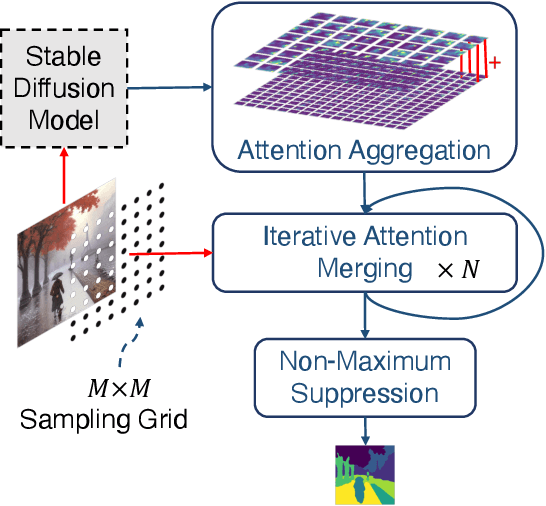
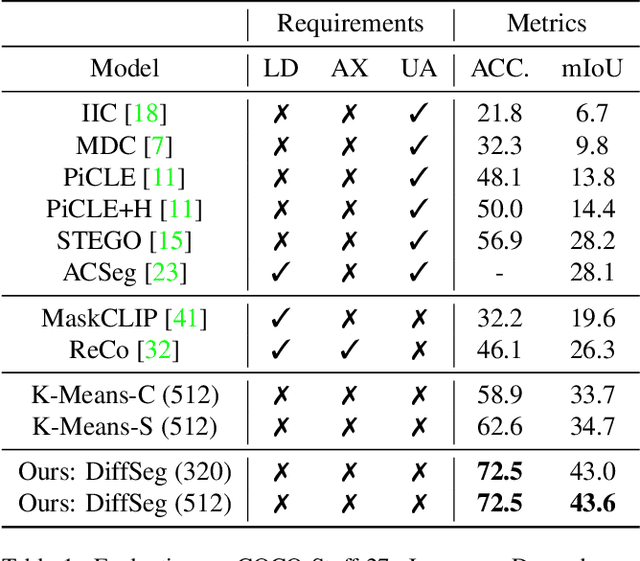

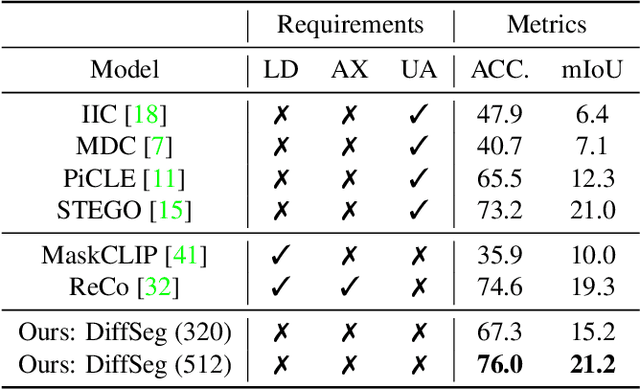
Abstract:Producing quality segmentation masks for images is a fundamental problem in computer vision. Recent research has explored large-scale supervised training to enable zero-shot segmentation on virtually any image style and unsupervised training to enable segmentation without dense annotations. However, constructing a model capable of segmenting anything in a zero-shot manner without any annotations is still challenging. In this paper, we propose to utilize the self-attention layers in stable diffusion models to achieve this goal because the pre-trained stable diffusion model has learned inherent concepts of objects within its attention layers. Specifically, we introduce a simple yet effective iterative merging process based on measuring KL divergence among attention maps to merge them into valid segmentation masks. The proposed method does not require any training or language dependency to extract quality segmentation for any images. On COCO-Stuff-27, our method surpasses the prior unsupervised zero-shot SOTA method by an absolute 26% in pixel accuracy and 17% in mean IoU.
HePCo: Data-Free Heterogeneous Prompt Consolidation for Continual Federated Learning
Jun 16, 2023

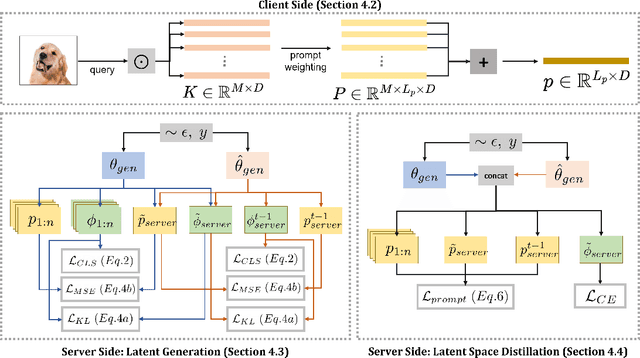

Abstract:In this paper, we focus on the important yet understudied problem of Continual Federated Learning (CFL), where a server communicates with a set of clients to incrementally learn new concepts over time without sharing or storing any data. The complexity of this problem is compounded by challenges from both the Continual and Federated Learning perspectives. Specifically, models trained in a CFL setup suffer from catastrophic forgetting which is exacerbated by data heterogeneity across clients. Existing attempts at this problem tend to impose large overheads on clients and communication channels or require access to stored data which renders them unsuitable for real-world use due to privacy. In this paper, we attempt to tackle forgetting and heterogeneity while minimizing overhead costs and without requiring access to any stored data. We achieve this by leveraging a prompting based approach (such that only prompts and classifier heads have to be communicated) and proposing a novel and lightweight generation and distillation scheme to consolidate client models at the server. We formulate this problem for image classification and establish strong baselines for comparison, conduct experiments on CIFAR-100 as well as challenging, large-scale datasets like ImageNet-R and DomainNet. Our approach outperforms both existing methods and our own baselines by as much as 7% while significantly reducing communication and client-level computation costs.
Trainable Projected Gradient Method for Robust Fine-tuning
Mar 28, 2023Abstract:Recent studies on transfer learning have shown that selectively fine-tuning a subset of layers or customizing different learning rates for each layer can greatly improve robustness to out-of-distribution (OOD) data and retain generalization capability in the pre-trained models. However, most of these methods employ manually crafted heuristics or expensive hyper-parameter searches, which prevent them from scaling up to large datasets and neural networks. To solve this problem, we propose Trainable Projected Gradient Method (TPGM) to automatically learn the constraint imposed for each layer for a fine-grained fine-tuning regularization. This is motivated by formulating fine-tuning as a bi-level constrained optimization problem. Specifically, TPGM maintains a set of projection radii, i.e., distance constraints between the fine-tuned model and the pre-trained model, for each layer, and enforces them through weight projections. To learn the constraints, we propose a bi-level optimization to automatically learn the best set of projection radii in an end-to-end manner. Theoretically, we show that the bi-level optimization formulation could explain the regularization capability of TPGM. Empirically, with little hyper-parameter search cost, TPGM outperforms existing fine-tuning methods in OOD performance while matching the best in-distribution (ID) performance. For example, when fine-tuned on DomainNet-Real and ImageNet, compared to vanilla fine-tuning, TPGM shows $22\%$ and $10\%$ relative OOD improvement respectively on their sketch counterparts. Code is available at \url{https://github.com/PotatoTian/TPGM}.
* Accepted to CVPR2023
Polyhistor: Parameter-Efficient Multi-Task Adaptation for Dense Vision Tasks
Oct 07, 2022



Abstract:Adapting large-scale pretrained models to various downstream tasks via fine-tuning is a standard method in machine learning. Recently, parameter-efficient fine-tuning methods show promise in adapting a pretrained model to different tasks while training only a few parameters. Despite their success, most existing methods are proposed in Natural Language Processing tasks with language Transformers, and adaptation to Computer Vision tasks with Vision Transformers remains under-explored, especially for dense vision tasks. Further, in multi-task settings, individually fine-tuning and storing separate models for different tasks is inefficient. In this work, we provide an extensive multi-task parameter-efficient benchmark and examine existing parameter-efficient fine-tuning NLP methods for vision tasks. Our results on four different dense vision tasks showed that existing methods cannot be efficiently integrated due to the hierarchical nature of the Hierarchical Vision Transformers. To overcome this issue, we propose Polyhistor and Polyhistor-Lite, consisting of Decomposed HyperNetworks and Layer-wise Scaling Kernels, to share information across different tasks with a few trainable parameters. This leads to favorable performance improvements against existing parameter-efficient methods while using fewer trainable parameters. Specifically, Polyhistor achieves competitive accuracy compared to the state-of-the-art while only using ~10% of their trainable parameters. Furthermore, our methods show larger performance gains when large networks and more pretraining data are used.
FedFOR: Stateless Heterogeneous Federated Learning with First-Order Regularization
Sep 21, 2022



Abstract:Federated Learning (FL) seeks to distribute model training across local clients without collecting data in a centralized data-center, hence removing data-privacy concerns. A major challenge for FL is data heterogeneity (where each client's data distribution can differ) as it can lead to weight divergence among local clients and slow global convergence. The current SOTA FL methods designed for data heterogeneity typically impose regularization to limit the impact of non-IID data and are stateful algorithms, i.e., they maintain local statistics over time. While effective, these approaches can only be used for a special case of FL involving only a small number of reliable clients. For the more typical applications of FL where the number of clients is large (e.g., edge-device and mobile applications), these methods cannot be applied, motivating the need for a stateless approach to heterogeneous FL which can be used for any number of clients. We derive a first-order gradient regularization to penalize inconsistent local updates due to local data heterogeneity. Specifically, to mitigate weight divergence, we introduce a first-order approximation of the global data distribution into local objectives, which intuitively penalizes updates in the opposite direction of the global update. The end result is a stateless FL algorithm that achieves 1) significantly faster convergence (i.e., fewer communication rounds) and 2) higher overall converged performance than SOTA methods under non-IID data distribution. Importantly, our approach does not impose unrealistic limits on the client size, enabling learning from a large number of clients as is typical in most FL applications.
Open-Set Semi-Supervised Object Detection
Aug 29, 2022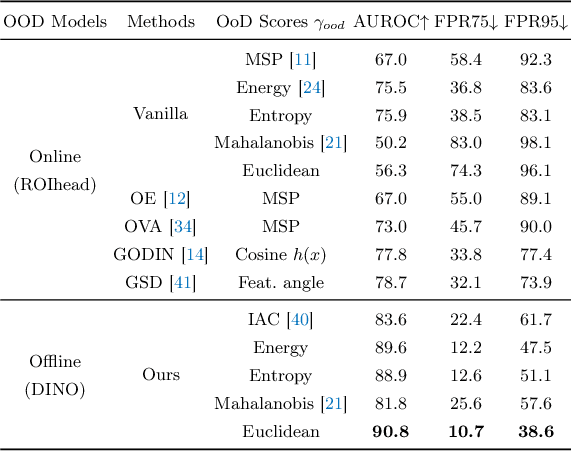
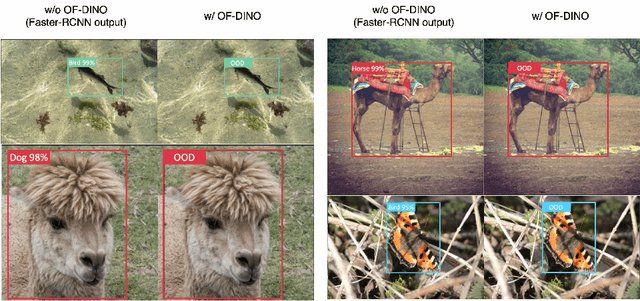


Abstract:Recent developments for Semi-Supervised Object Detection (SSOD) have shown the promise of leveraging unlabeled data to improve an object detector. However, thus far these methods have assumed that the unlabeled data does not contain out-of-distribution (OOD) classes, which is unrealistic with larger-scale unlabeled datasets. In this paper, we consider a more practical yet challenging problem, Open-Set Semi-Supervised Object Detection (OSSOD). We first find the existing SSOD method obtains a lower performance gain in open-set conditions, and this is caused by the semantic expansion, where the distracting OOD objects are mispredicted as in-distribution pseudo-labels for the semi-supervised training. To address this problem, we consider online and offline OOD detection modules, which are integrated with SSOD methods. With the extensive studies, we found that leveraging an offline OOD detector based on a self-supervised vision transformer performs favorably against online OOD detectors due to its robustness to the interference of pseudo-labeling. In the experiment, our proposed framework effectively addresses the semantic expansion issue and shows consistent improvements on many OSSOD benchmarks, including large-scale COCO-OpenImages. We also verify the effectiveness of our framework under different OSSOD conditions, including varying numbers of in-distribution classes, different degrees of supervision, and different combinations of unlabeled sets.
 Add to Chrome
Add to Chrome Add to Firefox
Add to Firefox Add to Edge
Add to Edge